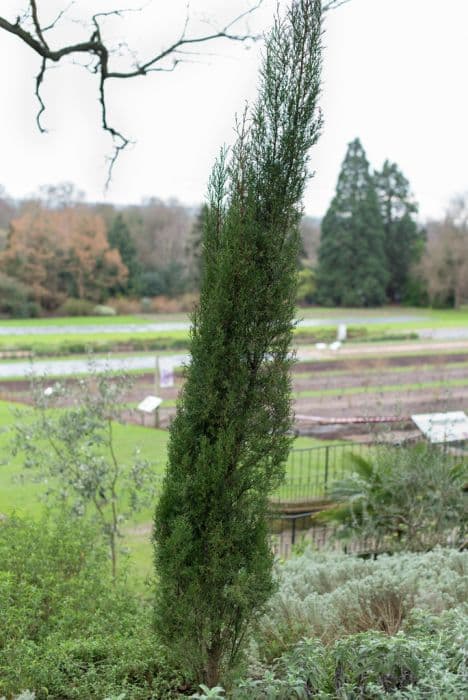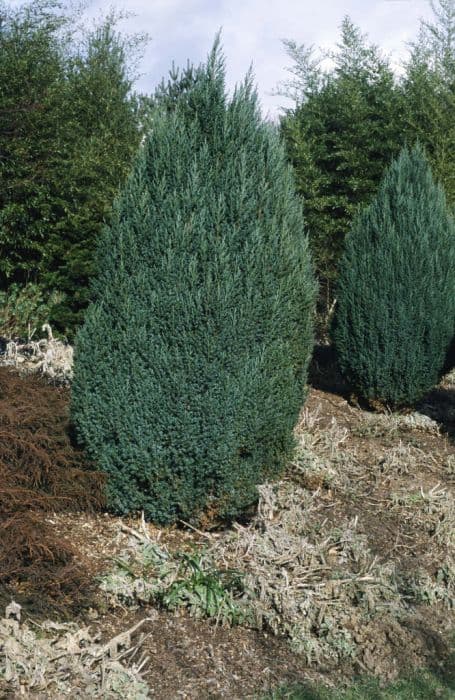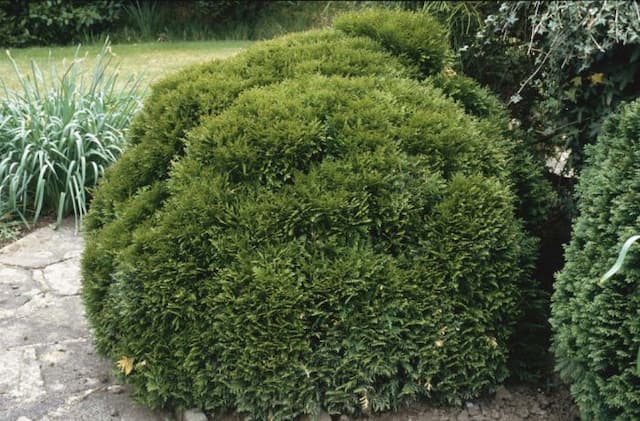Swamp cypress Taxodium distichum



ABOUT
Taxodium distichum, also known as bald cypress, is a large, deciduous coniferous tree that can reach a height of 100-150 feet and a diameter of 6-8 feet. It has a straight trunk with a conical shape that is covered in a fibrous, reddish-brown bark. The branches are arranged in a flat-topped, umbrella-like shape, giving it a distinctive appearance.
The leaves of Taxodium distichum are needle-like, measuring about 0.5-1 inches long and are arranged in feather-like sprays. They are a soft, light green color in the spring and summer and turn orange-brown in the fall.
The tree produces small, inconspicuous flowers that are followed by small, round cones that measure about 0.5-1 inches in diameter. The cones are green when they first appear, turning brown as they mature.
It's worth noting that the size of the Taxodium distichum tree can vary depending on the conditions in which it grows. Trees grown in poor soil or other adverse conditions will be smaller than those grown in optimal conditions.
About this plant
 Names
NamesFamily
Cupressaceae
Synonyms
Swamp cypress, Bald cypress, Deciduous cypress, Sabino tree, Southern cypress, White cypress, Baldcypress, Cypress
Common names
Taxodium distichum var. distichum
 Toxicity
ToxicityTo humans
Taxodium distichum is not considered toxic to humans, and it is not known to cause any adverse reactions when ingested or touched.
It is safe to be planted in gardens and around homes.To pets
Taxodium distichum is not considered toxic to animals either. It does not cause any significant harm to animals when ingested, and it is safe to be planted in yards and gardens where animals may roam.
However, it's worth noting that as with any plant, it's best to always supervise animals when they're near unfamiliar plants.
 Characteristics
CharacteristicsLife cycle
Perennials
Foliage type
Deciduous
Color of leaves
Green, orange in the fall
Flower color
Green
Height
Up to 150 feet
Spread
Up to 8 feet
Plant type
Tree
Hardiness zones
5
Native area
North America
Benefits
 General Benefits
General BenefitsThe tree has a unique and striking appearance, with a conical shape, feathery leaves, and fibrous bark. It's a popular ornamental tree in parks and gardens;
The tree provides food and shelter for a variety of wildlife, such as birds, squirrels, and deer;
The tree's extensive root system helps to stabilize the soil and prevent erosion, making it a useful plant for landscaping in areas prone to erosion;
The tree is tolerant of a wide range of soil and climatic conditions, making it suitable for planting in a variety of regions;
The tree is well adapted to wet conditions, and it's also known to tolerate flooding, and drought;
Taxodium distichum is known to sequester large amount of carbon and is considered as a carbon sink;
The tree has a long lifespan, with some specimens living for over 1000 years. Medical Properties
Medical PropertiesTaxodium distichum, also known as bald cypress, has been traditionally used in some cultures for its medicinal properties. However, it is important to note that the medicinal properties of this plant have not been widely studied and it's important to consult a specialist before using it:
The bark of the tree is believed to have astringent properties, which can help to tighten and firm the skin;
The tree's bark and needles are believed to have anti-inflammatory properties, which may help to reduce swelling and pain;
Some studies have suggested that the bark of the tree may have anti-diabetic properties, which may help to lower blood sugar levels;
Some studies have suggested that the tree's bark may have antimicrobial properties, which may help to fight against bacterial and fungal infections. Other Uses
Other UsesThe tree is well adapted to wet conditions and its extensive root system helps to control and manage water levels. It's often used in wetlands and swamps to help control erosion and flooding;
The tree is often used in landscaping as it is drought-tolerant and can be planted in a wide range of soils, it's also a good option for planting in wetland and lowland areas;
The tree can be trained to grow in a small size, which makes it a suitable option for bonsai cultivation;
The tree is known to have rot-resistant wood which makes it a good option for outdoor construction and boat building;
Taxodium distichum is known to sequester large amount of carbon and is considered as a carbon sink.
Interesting Facts
 Plant Symbolism
Plant SymbolismTaxodium distichum is known to be a symbol of strength, durability, and longevity. The tree's ability to survive in wetland and lowland areas, as well as its long lifespan, make it a symbol of resilience and adaptability.
 Water
WaterTaxodium distichum, also known as bald cypress, is adaptable to a wide range of soil types and moisture levels.
However, it prefers moist soil and regular watering during its establishment period, after that it can tolerate drought. Watering once a week should be sufficient, but it's important to monitor the soil moisture and adjust the watering schedule as needed.
In the hot summer months, it may be necessary to water more frequently. Light
LightTaxodium distichum is adaptable to a range of lighting conditions, from medium to partial shade.
It can tolerate full sun, but it's also well-suited to grow in partial shade. Temperature
TemperatureTaxodium distichum is native to the southeastern United States and is hardy in USDA zones 6 to 9, which means it can tolerate temperatures as low as -20°F.
It prefers temperatures between 60 to 70°F, but can tolerate a range of temperatures between -20°F to 100°F.
The tree is also tolerant of high humidity, which is common in its native range. Pruning
PruningTaxodium distichum is a slow-growing tree, and it doesn't require frequent pruning. Prune the tree in late winter or early spring, before new growth appears. Prune any dead, damaged, or diseased branches, and remove any branches that are crossing or rubbing against each other. Also, if you want to shape the tree, you can remove the lower branches to create a clear trunk. It's important to use sharp, clean pruning shears and make clean, angled cuts. Avoid pruning too much in one year as it can cause stress to the tree.
 Soil
SoilTaxodium distichum, also known as bald cypress, is adaptable to a wide range of soil types, including wet soils and poorly-drained soils.
It prefers slightly acidic to neutral soil, with a pH range of 6 to 7.5. However, it can tolerate a wide range of soil pH levels, from 4.5 to 8.5.
It also prefers soil that is rich in organic matter, but it can tolerate sandy, clay, or rocky soils as well. Humidity & Misting
Humidity & MistingTaxodium distichum is native to the southeastern United States, where humidity levels are high.
It is tolerant of high humidity, and it prefers a consistent level of moisture in the air. It can tolerate dry air, but it may struggle in extremely dry conditions.
In areas with low humidity, it is important to monitor the soil moisture and water the tree regularly to ensure that it has enough moisture. Suitable locations
Suitable locationsIndoor
Not growing
Outdoor
All year round.
It is a hardy tree that is well-suited to grow outdoors in a wide range of conditions.
The tree prefers medium to full sun and can tolerate temperatures as low as -20°F.Hardiness zone
6 - 10 USDA
 Life cycle
Life cycleThe life cycle of Taxodium distichum begins as a seed. The seeds are produced in the fall, and they mature within a cone-like structure called a strobilus. Once mature, the seeds are dispersed by the wind, and they germinate in the spring.
The first stage of life for the bald cypress is the seedling stage, which lasts for about 2-3 years. During this stage, the tree develops a taproot and a number of lateral roots. The seedling's leaves are needle-like and are arranged in a spiral pattern along the stem.
The sapling stage, which lasts for about 10-15 years. During this stage, the tree continues to develop its root system and begins to grow taller. The tree's leaves become longer and flatter, and the tree's trunk begins to thicken.
The mature stage begins around 20-25 years of age. During this stage, the tree reaches its full height and the trunk becomes fully developed. The tree's leaves become even longer and flatter, and the tree begins to produce cones. At this stage the tree is able to reproduce. Propogation
PropogationPropogation time
Spring - early summer
By SEEDS:
The seeds of Taxodium distichum can be collected in the fall, after the cones have matured and turned brown. They should be cleaned of any debris and then stratified (stored in a moist, cool place) for 90 days before planting. The seeds should be sown in seed trays or pots filled with seed compost and kept moist, in a cold frame or unheated greenhouse. Germination can be slow and erratic, taking anywhere from several weeks to several months.
By LAYERING:
Layering is another method for propagating Taxodium distichum. This involves bending a low-lying branch down to the ground and covering it with soil. The branch will then root and can be severed from the parent plant.
 Pests
PestsBagworms
 Diseases
DiseasesRoot Rot, Canker









